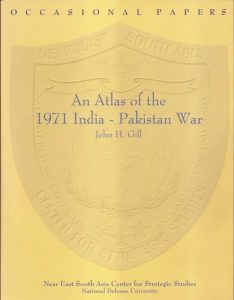In the fourth segment of NESA South Asia Interview Series, Professor Hassan Abbas interviews Professor Jack Gill of the Near East South Asia Center for Strategic Studies.

John H (Jack) Gill, a military historian, serves as a professor at NESA. A former South Asia foreign area officer, he retired as a colonel in 2005. He also served as military advisor to Ambassador James Dobbins, the US envoy to the Afghan opposition forces (2001-02) and as a liaison officer to the Pakistan army for US forces in Afghanistan (2003-04). His publications include The 1971 India-Pakistan War: An Atlas and many monographs and book chapters covering security and political developments in the broader South Asia region. His deep research on European military and political history is reflected through his several works on the Napoleonic era, some of which are accessible here.
HASSAN ABBAS: My first question regards your excellent essay, Provocation, war, and restraint under the nuclear shadow: The Kargil conflict 1999, published last year in the Journal of Strategic Studies. Kindly help our readers understand the relevance of your findings to India-Pakistan geostrategic competition today.
JACK GILL: This is a good question because the 1999 Kargil conflict continues to resonate today. Indian media and think tank commentary, for instance, repeatedly refers to Kargil when analyzing the recent intrusions by China across the Line of Actual Control (LAC) in Ladakh. Drawing from last year’s article, I think we can suggest a number of important repercussions from the Kargil war.
First, the conflict and the lurking danger of nuclear escalation solidified the Kashmir Line of Control (LOC) as a quasi–international border, one that is unlikely to change in the foreseeable future. Moreover, Kargil again demonstrated that there was no international appetite for shifting borders as a perceived reward for overt military force or covert militancy.
Second, the Kargil misadventure contributed to a hardening of Indian attitudes towards negotiations over the Siachen Glacier dispute, making what had been seen as “low–hanging fruit” much more difficult. Kargil reinforced the view in India—especially within the army—that Pakistan aims to alter the status quo by force and can thus not be trusted even when diplomatic relations seem to be improving (as Kargil occurred after Indian Prime Minister A. B. Vajpayee’s historic bus visit to Lahore in Pakistan earlier that same year).

Third, Kargil illustrated the danger inherent in military operations in remote and highly sensitive areas where relatively junior officers with loose guidance and limited supervision might engage in what they see as reasonable tactical actions that have strategic ramifications. This sort of tactical miscalculation leading to strategic escalation remains a danger along the India-Pakistan LOC today, but it is also evident in the current China-India confrontation in Ladakh. Although China’s assertive behavior in recent months almost certainly occurred with Beijing’s direction and approval, it seems unlikely that China’s leaders wanted bloodshed to result; rather, it seems probable that the fatal clash on 15 June resulted from actions by junior leaders and ordinary soldiers that escalated in an unplanned and likely undesired manner.
Finally, returning to India-Pakistan, Kargil demonstrated that the threat of strategic miscalculation remains significant. The bilateral relationship is often characterized by sketchy intelligence and worst–case analysis overlaid on enduring historical enmity. Even senior and experienced leaders on both sides believe they understand one another when, unfortunately, their two perspectives are separated by a wide gap that is rarely bridged; hardly a reassuring situation given that both are nuclear weapons states.
HASSAN ABBAS: Since the 2008 terrorist attacks in Mumbai, India-Pakistan relations never really recovered despite some heads-of-state meetings, especially between Pakistan’s Prime Minister Nawaz Sharif and Indian Prime Minister Narendra Modi in 2014-15. The 2019 Balakot confrontation and especially India’s recent constitutional maneuvers in its portion of Kashmir further complicated relations. In your opinion, what needs to happen to reverse these trends, improving the prospects of peace in South Asia? How can the US support such endeavors?
JACK GILL: Sadly, this is a case of seemingly perdurable, visceral animosity mired in unresolvable historical resentments, often based on skewed interpretations of the past. Two points seem to me immediately apparent, First, halting terrorism is a must (as U.S. Administrations of both parties have stressed repeatedly). Second, promoting human security, protecting the constitutional rights of citizens and strengthening democracy on both sides of the Line of Control (LOC) would help enormously. However, there is unlikely to be any change in which country administers which territory any time in the near- to mid-term future, if ever. Therefore, LOC-management is required to reduce exchanges of fire (indeed, one hopes, to eliminate them altogether), to limit the possibility of escalation and to contain crises should they erupt. There are plenty of ideas out there as suggested by formal dialogues, Track 2 forums and other venues for many years, but implementation (such as renewal, updating and codification of the 2003 LOC ceasefire) will require political will that can only come from New Delhi and Islamabad.
As for the U.S., the long-standing stance of (1) quietly engaging with both countries on a routine basis while (2) being ready to act in crisis seems to me the best course. This means it is important for the U.S. government to reevaluate its “playbook” for India-Pakistan crises constantly. Their bilateral relations, the regional situation and the degree of influence the U.S. and other outsiders can wield is always in flux. In other words, what worked in 1999, 2000, 2008 or 2019 (as far as we can tell) may not work in the future and close, continual assessment is needed to remain viably engaged as circumstances change. But that is just crisis management and it may not always work. The two countries and the region were in many ways lucky in 2019 and brinkmanship by either side could easily overwhelm international efforts to urge cessation of potentially uncontrollable escalation. Ultimately, of course, only India and Pakistan can resolve and normalize their relations. The United States cannot want India-Pakistan rapprochement more than they do and Washington cannot “force” either New Delhi or Islamabad into an arrangement one or the other views as antithetical to its vital national interests.
HASSAN ABBAS: Moving on to the Sino-Indian rivalry that is unraveling before us, which historical events involving the two nations are worth reviewing to fully comprehend the nature and scope of this relationship?
JACK GILL: we can make two observations here. I think the first point to highlight from history is that there is no easy historical answer. That is, one cannot look back to some recognized treaty or agreement from the past and simply apply it to today’s situation; the origins of the perceived borders are far too fuzzy and contested. If we take that as a starting point, we are left with the implication that a solution can only come about through a political agreement between the two sides with the further implication that both Beijing and New Delhi will have to take decisions that will be very tough in their respective domestic political milieus. “Tough” is not “impossible,” but constant reiteration of maximumalist positions is not helpful and such pronouncements make “selling” any kind of political solution domestically more difficult.
The second historical point is simply the importance of history in understanding the contemporary environment in South Asia. That means that we as outsiders need to be at least conversant with both history and how history has been interpreted and socialized in the respective governments and political elites. Americans or others who want to analyze the current Sino-Indian confrontation, to read how both sides view it and to imagine how it might develop, will need at least a working understanding of the 1962 war (as antique as that will seem to Americans) as well as the subsequent evolution of incidents and border management protocols. Just as with India and Pakistan, that certainly does not mean being eternally trammeled by the past (or popular interpretations of the past). The historical background, however, helps us comprehend the present and perhaps envisage a different, less conflictual future.

HASSAN ABBAS: India plays a pre-eminent role in the US Indo-Pacific strategy and with China’s assertive posture, especially in its neighborhood, US-India relations are likely to become even more important for both nations. How can the US help India make best use of its unique maritime geography in this scenario without overly provoking China?
JACK GILL: This is a challenge, but not an insurmountable one and it can be addressed in multiple areas. The first area people think of is defense and that is certainly important, but it is by no means the only “line of effort” the U.S. should pursue with India. In my opinion, the diplomatic and especially the economic opportunities are just as, if not more, important than defense initiatives to underwrite greater U.S.-India bilateral collaboration and to incorporate India into Asia more broadly. These could include measures on bilateral and multilateral trade as well as closer diplomatic consultation, building on such significant forums as the “2+2” dialogue of American Secretaries of State and Defense with their Indian counterparts. Strengthening the U.S.-Australia-Japan-India “Quad” already seems to be in the cards as an important diplomatic step. Closer alignment of Indian voting patterns in international organizations could also be useful, especially with India set to assume a non-permanent seat on the UN Security Council starting in January 2021. Although some Indians would view such cooperation as “submitting to American diktat,” the signal to Beijing would be clear (but non-threatening). On the defense side, inviting Australia to the annual U.S.-India “Malabar” naval exercise is an excellent proposal, but India could also be included in some of the other military training activities the U.S. undertakes, especially with ASEAN, GCC and African friends. These need not be “hard” military training events but could focus on humanitarian relief/disaster response and other topics in which India has both an interest and a demonstrated capability. Furthermore, as I have suggested elsewhere, the U.S. should expand invitations to Indian officers of all services to attend U.S. military educational institutions or to avail themselves of training opportunities (even brief, one- to two-week programs) in the United States as soon as the global health situation permits.
Some analysts would likely argue that decision-makers in Beijing believe they have already “lost” India to some kind of American embrace. If so, that would be a gross overreading of the U.S.-India relationship in my view, but Washington will have to expect a certain degree of rhetorical annoyance from China on almost anything it does with India. The difficulty will lie in discerning where rhetorical annoyance begins to shade into Chinese perceptions of dire threats to vital national security interests, so that the U.S. can calibrate its words and actions accordingly.
HASSAN ABBAS: Lastly, anything you would recommend our readers to particularly track for the future.
JACK GILL: An important and interesting issue to track over the coming months and years will be the India-China-Russia triangle in the wake of the June Sino-Indian border clash. New Delhi is in a situation of “path-dependency” with Moscow for weaponry given its huge stock of Soviet/Russian armaments and India-Russia ties are usually framed with glowing encomiums, but other than arms and warm embraces the content of the relationship is thin. Moreover, there are potentially significant fissures in their views of the world, such as Russia’s recent cozying up with the Taliban (directly threatening to India’s national security if the Taliban grant sanctuary to anti-India terrorists) and, even more pointedly in the current circumstances, Russia’s sales of sophisticated arms to China (many of the same ones that are on offer to India) and the Kremlin’s seeming partnership with Beijing in other areas. All three are leading members of key international groupings such as the Shanghai Cooperation Organization (SCO), BRICS and, most notably, the Russia-India-China trilateral, but it is not yet clear how the recent Sino-Indian frictions will manifest themselves in such groupings, nor what role an apparently reticent Moscow will elect to play (if any) between New Delhi and Beijing. The United States, of course, figures in the calculations of all three, but where Russia and China consistently voice their opposition to the U.S., India’s approach is one of partnership, albeit at times more diffident than Washington would like. To cite just one example, the Kremlin derides the Indo-Pacific concept as a divisive American construct, but India has climbed aboard this vision (in its own interest and with its own coloration, to be sure, as in Prime Minister Modi’s 2018 address to the IISS Shangri-la Dialogue). This autumn’s annual Indo-Russian summit and forthcoming BRICS and SCO meetings will give us more clues to the future of this tangled triangle. It is certainly one to watch.
Be sure to read the earlier installments of the South Asia Series:
- Peace, Taliban and Cricket in Afghanistan: A Conversation with Afghan Leader and Diplomat Dr. Omar Zakhilwal
- Governance, Counterterrorism and Policing in Pakistan – A Conversation with Azhar Nadeem, Inspector General of Police (retired)
- Inside India Today: Politics, Security and the Rivalry with China – An Interview with Professor Christophe Jaffrelot
The views presented in this article are those of the speaker or author and do not necessarily represent the views of DoD or its components.